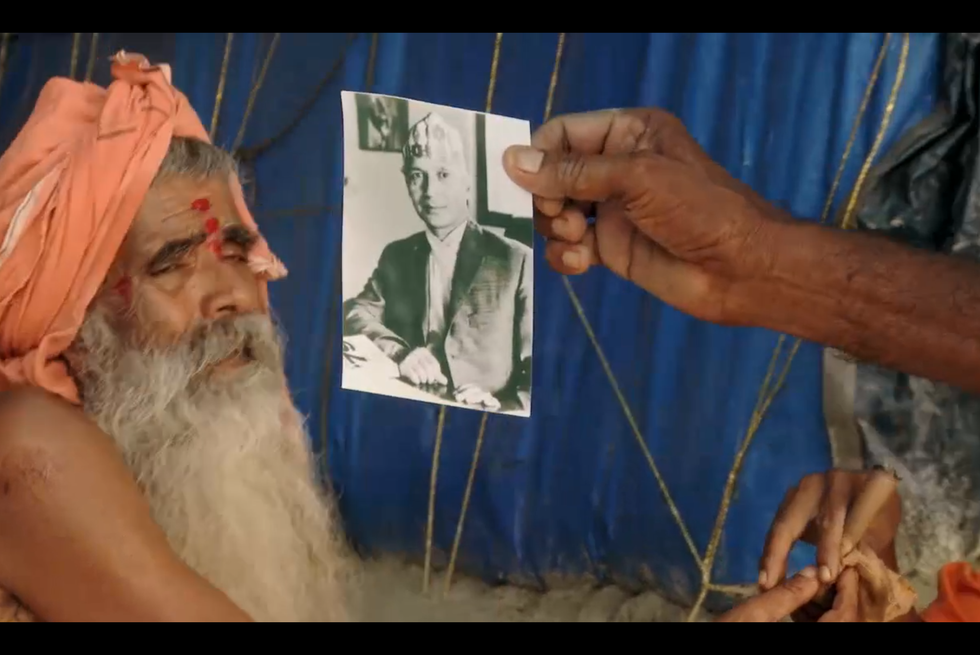Anthropology in the Margins
From the Series: Castaway Man
From the Series: Castaway Man

Castaway Man (2015), directed by Kesang Tseten, begins with a translator’s journey to Haridwar in the Indian Himalayas. He is looking for clues about Dor Bahadur Bista, the protagonist of his project, which is to bring Nepal’s foremost anthropologist’s magnum opus into the Nepali language for the first time. Bista, the tallest figure in Nepal’s anthropology, mysteriously disappeared without a trace two decades ago, and the Hindu ashrams of Haridwar were where he was rumored to have last been seen. The camera then turns to the societal and political web of the remote district of Jumla in Nepal where Bista’s world revolved just before he vanished.
Jumla is the land of barren mountains and blue skies where alcohol-drinking Khas Hindu high-caste people jostle with nature to make their living. Jumlis aspire modern development but are reluctant to let go of primordial traditions. Caught between these polar opposites, we discover the dwindling life and aspirations of a rebel anthropologist who had shunned the limelight of Kathmandu to be with them.
Castaway Man is not quite the Marlowean quest into the life and death of a man gone missing, and Bista is not a Nepali Kurtz by any means.1 But the film does evoke a series of unsettling binaries about civilizational light and darkness: It reminds us of the time when the contributions of a keen fieldworker and wanderer could not be acknowledged within the tradition of colonial ethnography that had led the young anthropologist to chart his own trajectories.2 Borrowing what has been said about comparable anthropological figures from elsewhere in the global South, Bista was an “authentic interlocutor” of Euro-American anthropology for whom ethnography was an epistemology that triggered his political awakening and social activism for reform (Nyoka 2020).
A decade after the end of the Maoist People’s War and ousting of Hindu monarchy, the film depicts a collage of Nepalis from various walks of life who testify that caste discrimination had not been done away with. This makes the film’s recollection of Bista’s lonely struggle against Brahmanism even more relevant.3 Bista’s rage against the status-quo of his times—as aired in his personal correspondences with family and friends—take us to the “what for” questions so often raised in non-hegemonic discourses of anthropology in the global South (Ribeiro and Escobar 2006).
Director Kesang Tseten is one of the best-known documentary film makers working on Nepal who has long collaborated with independent filmmakers from around South Asia. The film takes an observational approach and weaves its narrative through a series of free-wheeling conversations with the protagonist’s family and followers. Bista’s (1991) magnum opus, Fatalism and Development: Nepal’s Struggle for Modernization, is at the heart of its narrative on caste.
The film is less about academic anthropology in Nepal and more about the protagonist whose life and work it explores. We hear a Jumli woman recalling how buwa (father, referring to Bista) had wanted her to read and write, as well as learn to cook and clean properly, which others found lusty and offensive. We are led to other snippets of Bista’s (failed) social reform as the Jumli people reminisce over their “lost chance” to develop and modernize. The building that once housed Bista’s anthropological raison d’etre laid bare. The film ends with a reflection on the irony of rumors about him being sighted in Haridwar, the heartland of the Hindu Brahmanical tradition he so passionately despised throughout his life.
1. Christopher Marlowe was an Elizabethan playwright and poet. Kurtz is the main character of Joseph Conrad’s novella Heart of Darkness.
2. Dor Bahadur Bista initially worked with a SOAS-based anthropologist Christoph von Furer-Haimendorf during his fieldwork in Nepal, and later after coming into conflict with Furer-Haimendorf, went on to develop a specific field of Nepali anthropology to be taught in the only university in Nepal at the time (Fisher 1997).
3. Bista (2008, 58) defines Brahmanism as “that development beyond Vedic traditions based essentially in the Puranas, which heavily emphasizes fatalism through its stress on karmic determination, from which has developed the social organization of the varna or caste system.”
Bista, Dor Bahadur. 1991. Fatalism and Development: Nepal’s Struggle for Modernization. Hyderabad, India: Orient Blackswan.
Fisher, James F. 1997. “An Interview with Dor Bahadur Bista.” HIMALAYA 17, no. 1: 25–32.
Nyoka, Bongani. 2020. The Social and Political Thought of Archie Mafeje. Johannesburg: Wits University Press.
Ribeiro, Gustavo L., and Arturo Escobar, eds. 2006. World Anthropologies: Disciplinary Transformations within Systems of Power. Oxford: Berg.